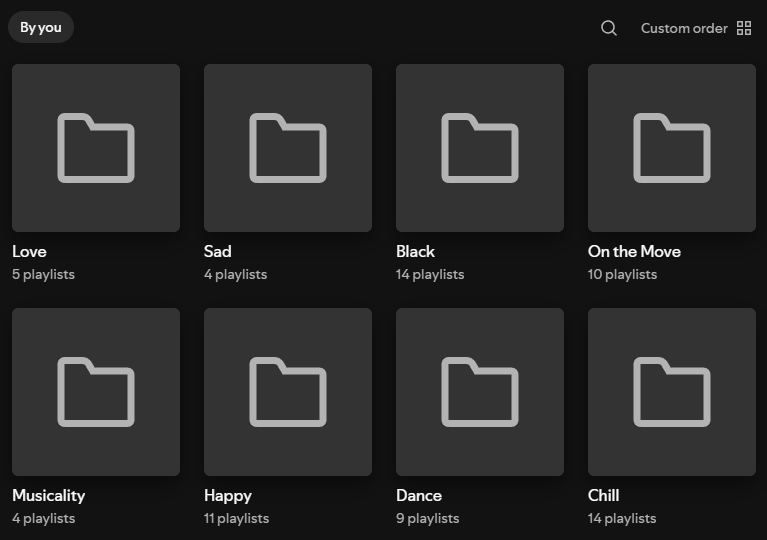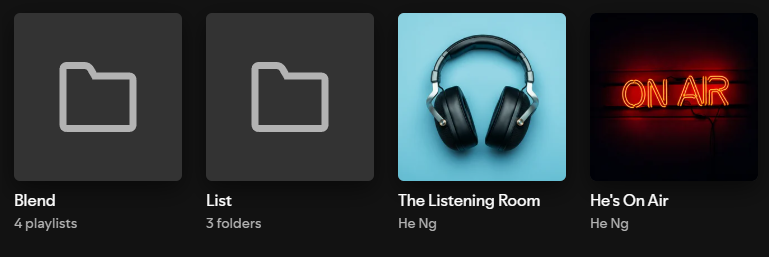Playlist Organisation
Do you ever hate how when you watched your Spotify wrap, your top artist is someone who you can’t even sing along with? Your top songs are a mess, only containing a handful of songs that you actually like? But what if you could control that, what if you can find the right tracks for the right moment every time, your Spotify wrap could more accurately reflect that. What if Spotify wrap is actually useful?
For me, this was a constant annoyance for about 8 years. But then I finally decided to do something about it and found my solution in treating my music library like a design project. It turns out that by organizing my playlists, I’m not just making it easier to find a song; I'm also honing a super important skill that every designer needs.
In this post, I want to show you exactly how I tackled the chaos and built a system that works. I truly believe it's one of the best ways to practice creating order out of anything—which is, you know, an essential skill for effective design.
Why I Treat My Spotify Like a Design Project
Do you ever hate how when you watched your Spotify Wrapped, your top artist is someone who you can’t even sing along with? Your top songs are a mess, only containing a handful of songs that you actually like? But what if you could control that? What if you could find the right tracks for the right moment every time, and your Spotify Wrapped could more accurately reflect that? What if Spotify Wrapped was actually useful?
For me, this was a constant annoyance for about 8 years. But then I finally decided to do something about it and found my solution in treating my music library like a design project. It turns out that by organizing my playlists, I’m not just making it easier to find a song; I'm also honing a super important skill that every designer needs.
In this post, I want to show you exactly how I tackled the chaos and built a system that works. I truly believe it's one of the best ways to practice creating order out of anything—which is, you know, an essential skill for effective design.
The Story: My Motivation for Organization
This all started because I was having a murder mystery party and wanted to find a playlist with the perfect atmosphere. I was inspired by a friend who had a playlist just for his parties, and I thought: "Wouldn't it be cool if I could play songs that start to hint at the plot?" From that moment on, I always had Spotify on whenever I worked, walked, or even showered.
The simple act of trying to figure out what songs to put in my playlists honestly ignited a new joy for me in listening to music. By having my playlists organized, it also unexpectedly helped me share music more easily. I can now effortlessly find the right genre or mood for my friends at the exact moment we’re together.
I think the reason I love organizing so much is that I personally don’t believe I have great short-term memory. I’m constantly looking for tools to offload those mental processes so I can focus 100% on the task at hand without worrying about anything else. It's a compromise I’ve come to enjoy in my daily life: I trust my systems completely. This extends to my music—having it organized helps to store all this information in a place where I know it will always be there when I need it.
The System: My Two-Section Approach
I have to admit, how I organize my playlists is a bit insane. A single person would probably have 10 playlists max, but I have over 100. They’re mainly there to serve as an archive.
I first split my playlists into two main sections: Genre and Mood.
Genre: The most common way of defining songs is by their genre, and songs within the same genre often evoke similar feelings. Although I don’t listen to these genre playlists often, they help me learn the most common way of organizing songs. After all, it must be the most common way for a reason. These playlists also serve as a reference for when I want to refer to a specific genre.
Mood: As not all songs within the same genre evoke the same feeling, I also make another section for just moods like: love, happy, sad, or dance. Even within these, I split them by their sound, like electronic dance, hip-hop dance, and jazz dance. I’m much more flexible here, and will sometimes put songs from similar genres into neighboring playlists. Just because you like jazz doesn’t mean you can’t enjoy a bit of pop, and sometimes that can be a conversation starter.
The Personal Touch: On top of my more systematic playlists, I also have a section for miscellaneous, personal playlists. These are for when I just want to listen to a specific collection of songs, like my favorites of all time or a playlist of karaoke songs. This shows that my system is flexible—it has a place for highly structured categories and a place for more subjective ones.
However, by combining songs like this into playlists, I would accidentally make a really weird-sounding mix. Because of this, I frequently go back and listen to a playlist and judge its effectiveness and coherence. It takes a lot of time, but it’s worth it because it ensures the quality of my playlists. After all, how else can you know what feeling a song gives without listening to it?





The Takeaway: How This Makes Me a Better Designer
The reason I'm even writing about organizing music on a designer's blog is that I believe to be the best designer I can be, I need to be as organized as I can. This allows me to constantly focus on my task and get it done to the highest quality. By organizing something that isn't directly design-related, I’m honing my organization skills in an unorthodox way. I’m learning things that you wouldn’t typically learn on the field. This means that when it comes to organizing random stuff, I can bring in a new way of thinking that others cannot.
This skill also extends to my file management, which I’ll talk about in another post. Like my playlists, I have to put files into a logical structure to make them easier to find—like a tree.

